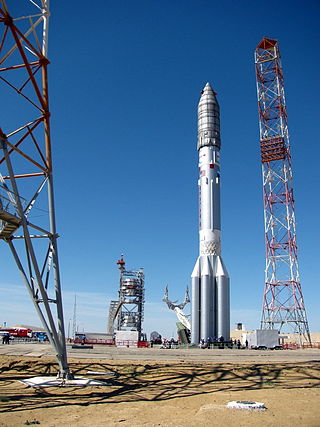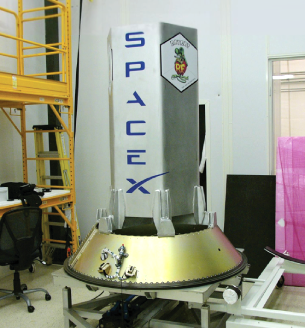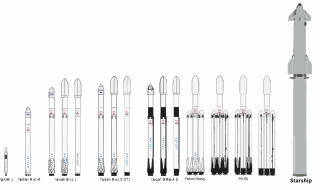
Ariane 5 is a retired European heavy-lift space launch vehicle developed and operated by Arianespace for the European Space Agency (ESA). It was launched from the Centre Spatial Guyanais (CSG) in French Guiana. It was used to deliver payloads into geostationary transfer orbit (GTO), low Earth orbit (LEO) or further into space. The launch vehicle had a streak of 82 consecutive successful launches between 9 April 2003 and 12 December 2017. Since 2014, Ariane 6, a direct successor system, is in development.

Space burial is the launching of human remains into space. Missions may go into orbit around the Earth or to extraterrestrial bodies such as the Moon, or farther into space.

Cascade, Smallsat and Ionospheric Polar Explorer (CASSIOPE), is a Canadian Space Agency (CSA) multi-mission satellite operated by the University of Calgary. The mission development and operations from launch to February 2018 was funded through CSA and the Technology Partnerships Canada program. In February, 2018 CASSIOPE became part of the European Space Agency's Swarm constellation through the Third Party Mission Program, known as Swarm Echo, or Swarm-E. It was launched September 29, 2013, on the first flight of the SpaceX Falcon 9 v1.1 launch vehicle. CASSIOPE is the first Canadian hybrid satellite to carry a dual mission in the fields of telecommunications and scientific research. The main objectives are to gather information to better understand the science of space weather, while verifying high-speed communications concepts through the use of advanced space technologies.

Falcon 1 was a small-lift launch vehicle that was operated from 2006 to 2009 by SpaceX, an American aerospace manufacturer. On 28 September 2008, Falcon 1 became the first privately developed fully liquid-fueled launch vehicle to go into orbit around the Earth.

A launch vehicle is typically a rocket-powered vehicle designed to carry a payload from Earth's surface or lower atmosphere to outer space. The most common form is the ballistic missile-shaped multistage rocket, but the term is more general and also encompasses vehicles like the Space Shuttle. Most launch vehicles operate from a launch pad, supported by a launch control center and systems such as vehicle assembly and fueling. Launch vehicles are engineered with advanced aerodynamics and technologies, which contribute to high operating costs.

Falcon 9 is a partially reusable medium-lift launch vehicle that can carry cargo and crew into Earth orbit, designed, manufactured and launched by American aerospace company SpaceX. It can also be used as an expendable heavy-lift launch vehicle. The first Falcon 9 launch was on 4 June 2010. The first Falcon 9 commercial resupply mission to the International Space Station (ISS) launched on 8 October 2012. In 2020 it became the first commercial rocket to ever launch humans to orbit and is currently the only such vehicle capable of doing so. It is the only U.S. rocket currently certified for transporting humans to the ISS. In 2022, it became the U.S. rocket with the most launches in history and with the best safety record, having suffered just one flight failure.

A payload fairing is a nose cone used to protect a spacecraft payload against the impact of dynamic pressure and aerodynamic heating during launch through an atmosphere. An additional function on some flights is to maintain the cleanroom environment for precision instruments. Once outside the atmosphere the fairing is jettisoned, exposing the payload to outer space.
Celestis, Inc. is a company that launches cremated human remains into space, a procedure known as a space burial. It is a subsidiary of the private space company Space Services Inc. The company purchases launches as a secondary payload on various launch vehicles, and launches samples of a person's cremated remains. Launching an individual's entire cremated remains would be prohibitively expensive for most people, so Celestis launches small portions of 1-7 grams.
The SpaceLoft XL is a sounding rocket developed by private spaceflight company UP Aerospace. The rocket is capable of lofting a 79 lb (36 kg) payload to a sub-orbital trajectory with an apogee of about 71.5 miles (115 km). It travels for approximately 60 seconds to cross the Kármán line. All launches are sub-orbital and do not complete one orbital revolution. Launches are conducted from the company launch facility at Spaceport America in Upham, New Mexico.
The Space Test Program (STP) is the primary provider of spaceflight for the United States Department of Defense (DoD) space science and technology community. STP is managed by a group within the Advanced Systems and Development Directorate, a directorate of the Space and Missile Systems Center of the United States Space Force. STP provides spaceflight via the International Space Station (ISS), piggybacks, secondary payloads and dedicated launch services.

The Proton-M, (Протон-М) GRAU index 8K82M or 8K82KM, is an expendable Russian heavy-lift launch vehicle derived from the Soviet-developed Proton. It is built by Khrunichev, and launched from sites 81 and 200 at the Baikonur Cosmodrome in Kazakhstan. Commercial launches are marketed by International Launch Services (ILS), and generally use Site 200/39. The first Proton-M launch occurred on 7 April 2001.
The Operationally Responsive Space Office is a joint initiative of several agencies within the United States Department of Defense (DoD). The "stand up" of the office took place 21 May 2007 at Kirtland Air Force Base. The first director of the ORS Office was Col. Kevin McLaughlin, who was also dual-hatted as commander of the Space Development and Test Wing located at Kirtland. The ORS Office focuses on providing quick-response tactical space-based capabilities to the warfighter utilizing smaller satellites, such as the Tactical Satellite Program and smaller launch vehicles.

NanoSail-D was a small satellite which was to have been used by NASA's Ames Research Center to study the deployment of a solar sail in space. It was a three-unit CubeSat measuring 30 cm × 10 cm × 10 cm, with a mass of 4 kg (8.8 lb). The satellite was lost shortly after launch due to a problem with the launch vehicle carrying it; however, a replacement, NanoSail-D2, was launched in 2010 to complete its mission.

RatSat or DemoSat was an aluminum mass simulator on the fourth flight of the Falcon 1 rocket, launched on 28 September 2008. Ratsat remained bolted to the second stage of the carrier rocket after reaching low Earth orbit. It is an aluminium alloy chamber in hexagonal prism shape with 1.5 m (5 ft) length.
Orbcomm is a family of low Earth orbit communications satellites, operated by the United States satellite communications company Orbcomm. As of July 2014, 51 such satellites have orbited Earth, with 50 still continuing to do so.

A space tug is a type of spacecraft used to transfer spaceborne cargo from one orbit to another orbit with different energy characteristics. The term can include expendable upper stages or spacecraft that are not necessarily a part of their launch vehicle. However, it can also refer to a spacecraft that transports payload already in space to another location in outer space, such as in the Space Transportation System concept. An example would be moving a spacecraft from a low Earth orbit (LEO) to a higher-energy orbit like a geostationary transfer orbit, a lunar transfer, or an escape trajectory.
The EELV Secondary Payload Adapter (ESPA) is an adapter for launching secondary payloads on orbital launch vehicles.

SpaceX manufactures launch vehicles to operate its launch provider services and to execute its various exploration goals. SpaceX currently manufactures and operates the Falcon 9 Full Thrust family of medium-lift launch vehicles and the Falcon Heavy family of heavy-lift launch vehicles – both of which powered by SpaceX Merlin engines and employing VTVL technologies to reuse the first stage. As of 2023, the company is also developing the fully reusable Starship launch system, which will replace the Falcon 9 and Falcon Heavy.
SHERPA is a commercial satellite dispenser developed by Andrews Space, a subsidiary of Spaceflight Industries, and was unveiled in 2012. The maiden flight was on 3 December 2018 on a Falcon 9 Block 5 rocket, and it consisted of two separate unpropelled variants of the dispenser.

Small Innovative Missions for Planetary Exploration (SIMPLEx) is a planetary exploration program operated by NASA. The program funds small, low-cost spacecraft for stand-alone planetary exploration missions. These spacecraft are intended to launch as secondary payloads on other missions and are riskier than Discovery or New Frontiers missions.












